Spatial Distribution of Tsunami Hazard Posed by Earthquakes along the Manila Trench
Abstract
:1. Introduction
2. Probabilistic Tsunami Hazard Assessment Model
3. Seismic Characteristics of the Manila Trench and Potential Tsunami Simulation
3.1. Study Area and Potential Earthquake Scenarios
3.2. Occurrence Probability of Each Earthquake Scenario
3.3. Simulation of Tsunami Triggered by Each Earthquake Scenario
4. Distribution Characteristics of Tsunami Hazard
5. Conclusions
Author Contributions
Funding
Data Availability Statement
Conflicts of Interest
References
- Hsu, Y.J.; Yu, S.B.; Song, T.R.A.; Bacolcol, T. Plate coupling along the Manila subduction zone between Taiwan and northern Luzon. J. Asian Earth Sci. 2012, 51, 98–108. [Google Scholar] [CrossRef]
- Karig, D.E. Accreted terranes in the northern part of the Philippine archipelago. Tectonics 1983, 2, 211–236. [Google Scholar] [CrossRef]
- Barrier, E.; Huchon, P.; Aurelio, M. Philippine fault: A key for Philippine kinematics. Geology 1991, 19, 32–35. [Google Scholar] [CrossRef]
- Yang, T.F.; Lee, T.; Chen, C.H.; Cheng, S.N.; Knittel, U.; Punongbayan, R.S.; Rasdas, A.R. A double island arc between Taiwan and Luzon: Consequence of ridge subduction. Tectonophysics 1996, 258, 85–101. [Google Scholar] [CrossRef]
- Hsu, Y.J.; Yu, S.B.; Loveless, J.P.; Bacolcol, T.; Solidum, R.; Luis, A.; Woessner, J. Interseismic deformation and moment deficit along the Manila subduction zone and the Philippine Fault system. J. Geophys. Res. Solid Earth 2016, 121, 7639–7665. [Google Scholar] [CrossRef] [Green Version]
- Megawati, K.; Shaw, F.; Sieh, K.; Huang, Z.; Wu, T.R.; Lin, Y.; Pan, T.C. Tsunami hazard from the subduction megathrust of the South China Sea: Part I. Source characterization and the resulting tsunami. J. Asian Earth Sci. 2009, 36, 13–20. [Google Scholar] [CrossRef]
- Liu, Y.; Santos, A.; Wang, S.M.; Shi, Y.; Liu, H.; Yuen, D.A. Tsunami hazards along Chinese coast from potential earthquakes in South China Sea. Phys. Earth Planet. Inter. 2007, 163, 233–244. [Google Scholar] [CrossRef]
- Wu, T.R.; Huang, H.C. Modeling tsunami hazards from Manila trench to Taiwan. J. Asian Earth Sci. 2009, 36, 21–28. [Google Scholar] [CrossRef]
- Dao, M.H.; Tkalich, P.; Chan, E.S.; Megawati, K. Tsunami propagation scenarios in the South China Sea. J. Asian Earth Sci. 2009, 36, 67–73. [Google Scholar] [CrossRef]
- Ren, Z.; Zhao, X.; Wang, B.; Dias, F.; Liu, H. Characteristics of wave amplitude and currents in South China Sea induced by a virtual extreme tsunami. J. Hydrodyn. 2017, 29, 377–392. [Google Scholar] [CrossRef]
- Ren, Y.; Wen, R.; Zhang, P.; Yang, Z.B.; Pan, R.; Li, X.J. Implications of local sources to probabilistic tsunami hazard analysis in south Chinese coastal area. J. Earthq. Tsunami 2017, 11, 1740001. [Google Scholar] [CrossRef]
- Annaka, T.; Satake, K.; Sakakiyama, T.; Yanagisawa, K.; Shuto, N. Logic-tree approach for probabilistic tsunami hazard analysis and its applications to the Japanese coasts. Tsunami Its Hazards Indian Pac. Ocean. 2007, 164, 577–592. [Google Scholar]
- Geist, E.L.; Parsons, T. Probabilistic analysis of tsunami hazards. Nat. Hazards 2006, 37, 277–314. [Google Scholar] [CrossRef]
- Grezio, A.; Marzocchi, W.; Sandri, L.; Gasparini, P. A Bayesian procedure for probabilistic tsunami hazard assessment. Nat. Hazards 2010, 53, 159–174. [Google Scholar] [CrossRef]
- Li, L.; Switzer, A.D.; Chan, C.H.; Wang, Y.; Weiss, R.; Qiu, Q. How heterogeneous coseismic slip affects regional probabilistic tsunami hazard assessment: A case study in the South China Sea. J. Geophys. Res. Solid Earth 2016, 121, 6250–6272. [Google Scholar] [CrossRef] [Green Version]
- Lorito, S.; Selva, J.; Basili, R.; Romano, F.; Tiberti, M.M.; Piatanesi, A. Probabilistic hazard for seismically induced tsunamis: Accuracy and feasibility of inundation maps. Geophys. J. Int. 2015, 200, 574–588. [Google Scholar] [CrossRef] [Green Version]
- Ren, Y.F.; Wen, R.Z.; Song, Y.Y. Recent progress of tsunami hazard mitigation in China. Epis. J. Int. Geosci. 2014, 37, 277–283. [Google Scholar]
- Zhang, X.; Niu, X. Probabilistic tsunami hazard assessment and its application to southeast coast of Hainan Island from Manila Trench. Coast. Eng. 2020, 155, 103596. [Google Scholar] [CrossRef]
- Gao, X.; Zhao, G.; Niu, X. An approach for quantifying nearshore tsunami height probability and its application to the Pearl River Estuary. Coast. Eng. 2022, 175, 104139. [Google Scholar] [CrossRef]
- Mori, N.; Goda, K.; Cox, D. Recent process in probabilistic tsunami hazard analysis (PTHA) for mega thrust subduction earthquakes. In The 2011 Japan Earthquake and Tsunami: Reconstruction and Restoration; Springer: Cham, Switzerland, 2018; pp. 469–485. [Google Scholar]
- Dziewonski, A.M.; Chou, T.A.; Woodhouse, J.H. Determination of earthquake source parameters from waveform data for studies of global and regional seismicity. J. Geophys. Res. Solid Earth 1981, 86, 2825–2852. [Google Scholar] [CrossRef]
- Ekström, G.; Nettles, M.; Dziewoński, A.M. The global CMT project 2004–2010: Centroid-moment tensors for 13,017 earthquakes. Phys. Earth Planet. Inter. 2012, 200, 1–9. [Google Scholar] [CrossRef]
- Giacomo, D.D.; Storchak, D.A.; Safronova, N.; Ozgo, P.; Harris, J.; Verney, R.; Bondár, I. A new ISC service: The bibliography of seismic events. Seismol. Res. Lett. 2014, 85, 354–360. [Google Scholar] [CrossRef]
- International Seismological Centre, Seismological Dataset Repository. Available online: https://doi.org/10.31905/6TJZECEY (accessed on 15 September 2022).
- Gutenberg, B.; Richter, C.F. Frequency of earthquakes in California. Bull. Seismol. Soc. Am. 1944, 34, 185–188. [Google Scholar] [CrossRef]
- Blaser, L.; Krüger, F.; Ohrnberger, M.; Scherbaum, F. Scaling relations of earthquake source parameter estimates with special focus on subduction environment. Bull. Seismol. Soc. Am. 2010, 100, 2914–2926. [Google Scholar] [CrossRef]
- Okada, Y. Surface deformation due to shear and tensile faults in a half-space. Bull. Seismol. Soc. Am. 1985, 75, 1135–1154. [Google Scholar] [CrossRef]
- Kanamori, H. Mechanism of tsunami earthquakes. Phys. Earth Planet. Inter. 1972, 6, 346–359. [Google Scholar] [CrossRef]
- Liu, P.L.F.; Woo, S.B.; Cho, Y.S. Computer Programs for Tsunami Propagation and Inundation; School of Civil and Environmental Engineering, Cornell University: Ithaca, NY, USA, 1998. [Google Scholar]
- Imamura, F.; Yalciner, A.C.; Ozyurt, G. Tsunami Modelling Manual. 2006. Available online: https://www.tsunami.irides.tohoku.ac.jp/media/files/_u/project/manual-ver-3_1.pdf (accessed on 15 September 2022).
- Chen, C.; Beardsley, R.C.; Cowles, G. An Unstructured Grid, Finite-Volume Coastal Ocean Model, FVCOM User Manual, 2nd ed.; SMAST/UMASSD Technical Report-06-0602; Sea Grant College Program, Massachusetts Institute of Technology: Cambridge, MA, USA, 2006; 315p. [Google Scholar]
- Liu, P.L.F.; Cho, Y.S.; Briggs, M.J.; Kanoglu, U.; Synolakis, C.E. Runup of solitary waves on a circular island. J. Fluid Mech. 1995, 302, 259–285. [Google Scholar] [CrossRef]
- Niu, X. Resonance of long waves around a circular island and its relation to edge waves. Eur. J. Mech.-B/Fluids 2021, 86, 15–24. [Google Scholar] [CrossRef]
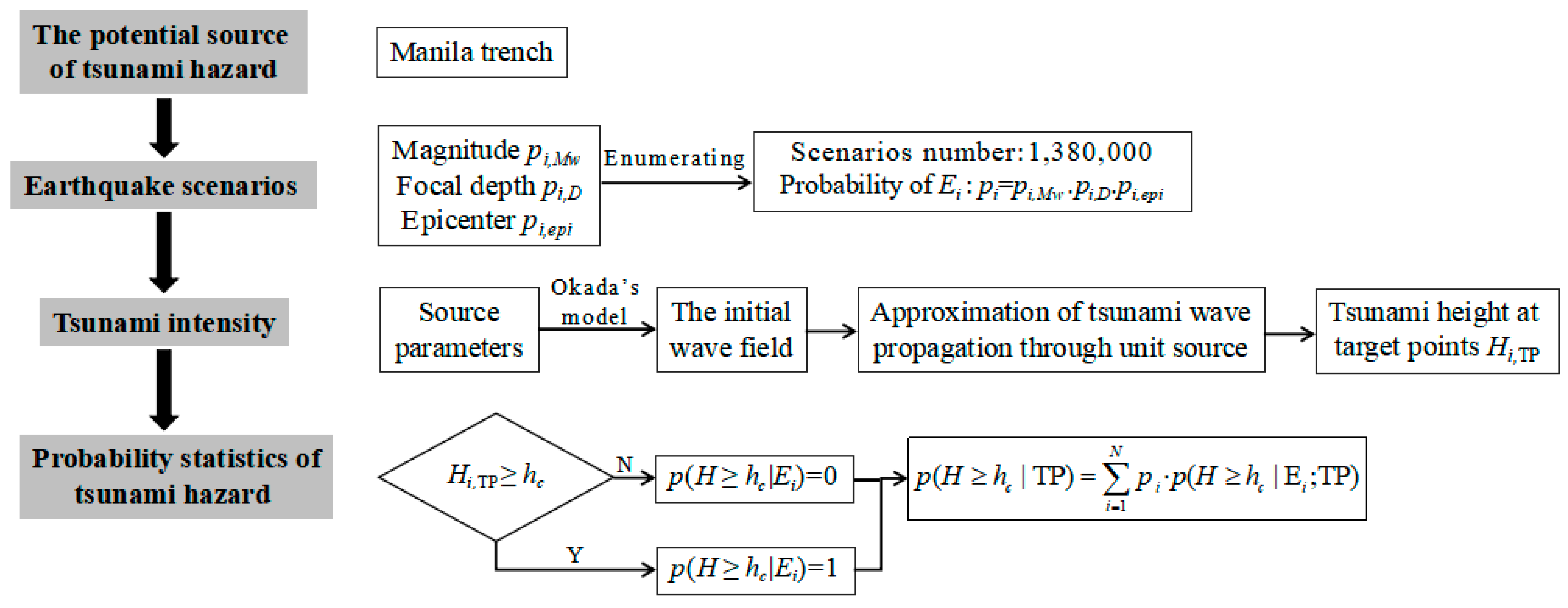
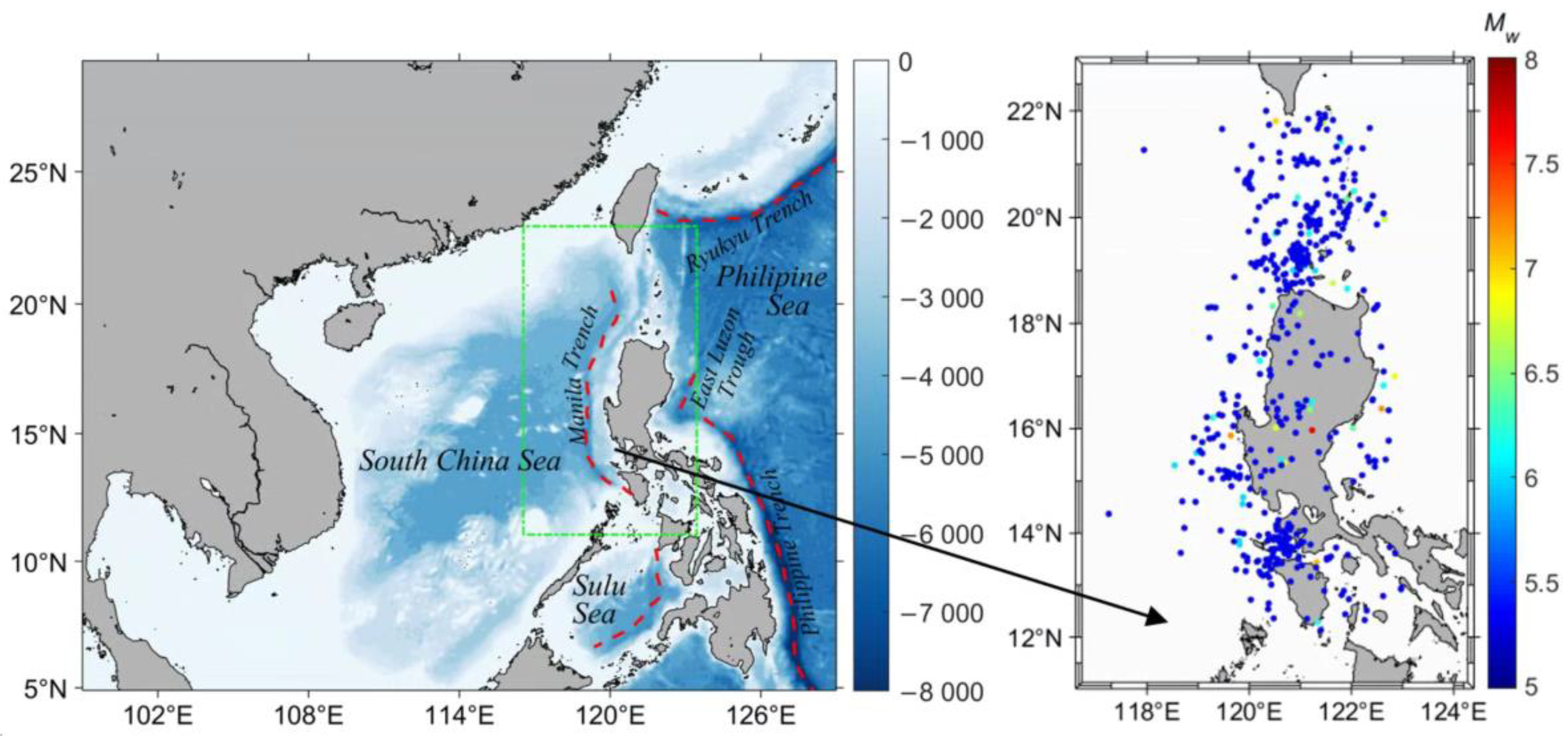

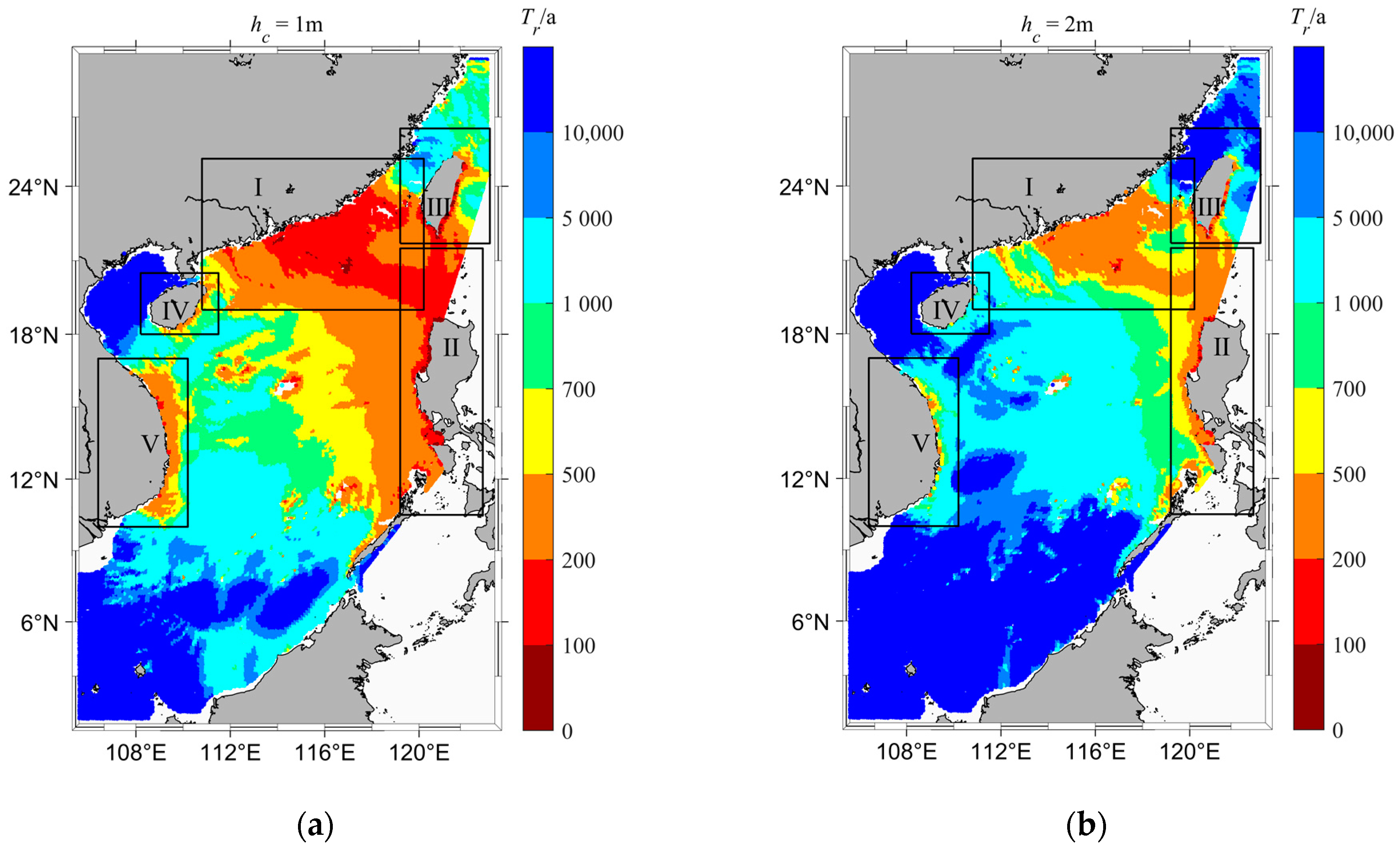


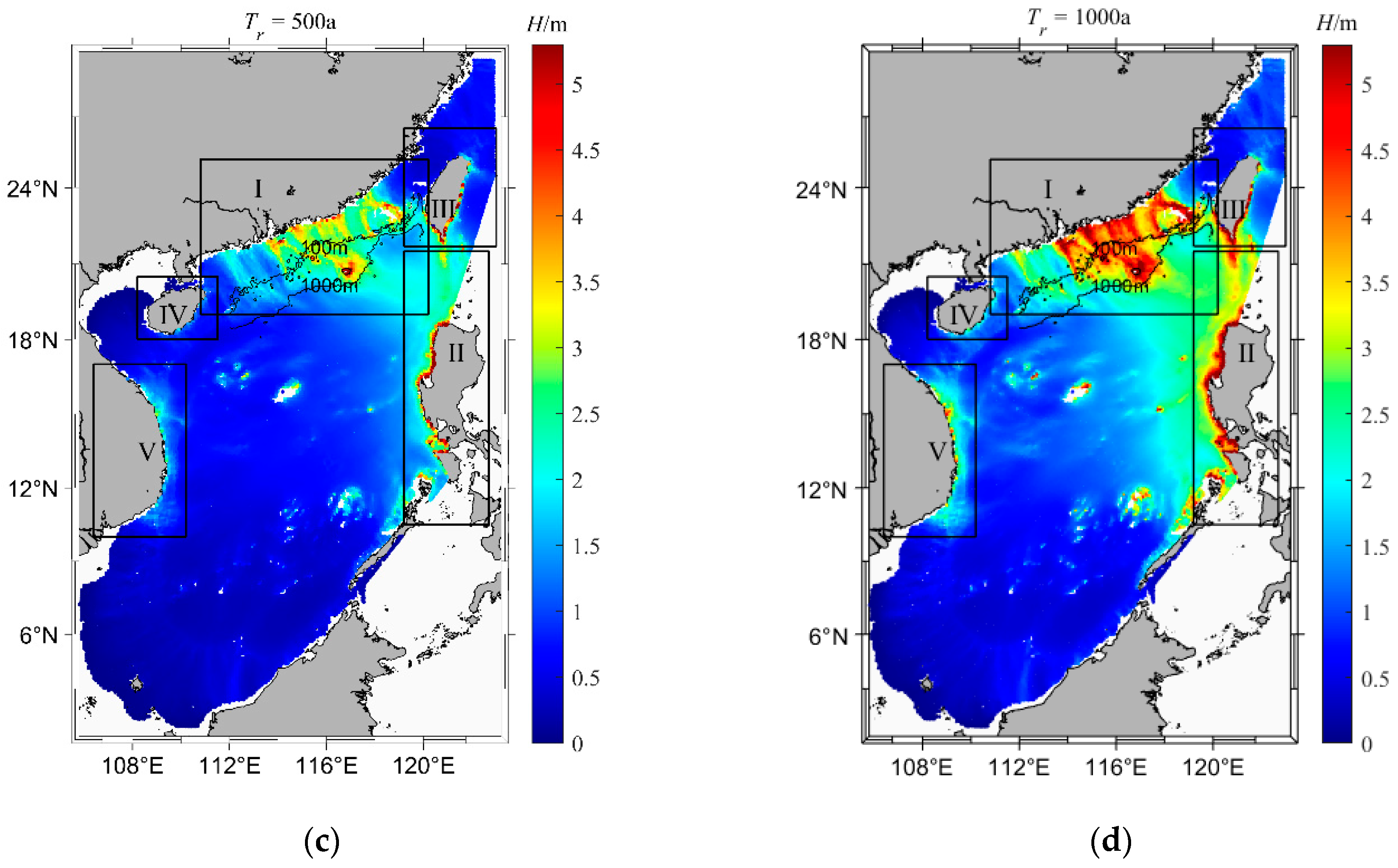
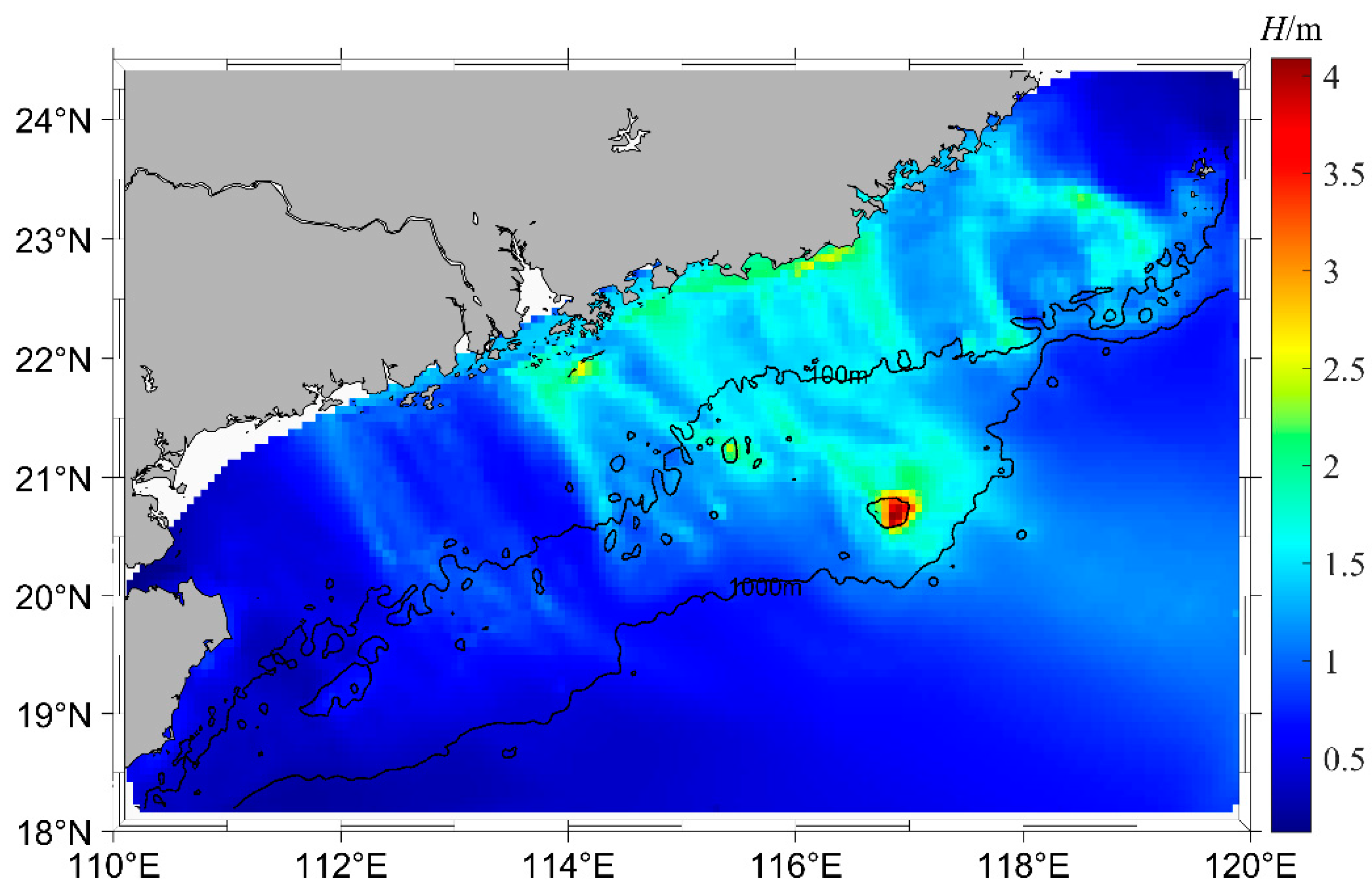
Publisher’s Note: MDPI stays neutral with regard to jurisdictional claims in published maps and institutional affiliations. |
© 2022 by the authors. Licensee MDPI, Basel, Switzerland. This article is an open access article distributed under the terms and conditions of the Creative Commons Attribution (CC BY) license (https://creativecommons.org/licenses/by/4.0/).
Share and Cite
Ma, F.; Zhao, G.; Gao, X.; Niu, X. Spatial Distribution of Tsunami Hazard Posed by Earthquakes along the Manila Trench. J. Mar. Sci. Eng. 2022, 10, 1449. https://doi.org/10.3390/jmse10101449
Ma F, Zhao G, Gao X, Niu X. Spatial Distribution of Tsunami Hazard Posed by Earthquakes along the Manila Trench. Journal of Marine Science and Engineering. 2022; 10(10):1449. https://doi.org/10.3390/jmse10101449
Chicago/Turabian StyleMa, Feng, Guangsheng Zhao, Xingyu Gao, and Xiaojing Niu. 2022. "Spatial Distribution of Tsunami Hazard Posed by Earthquakes along the Manila Trench" Journal of Marine Science and Engineering 10, no. 10: 1449. https://doi.org/10.3390/jmse10101449
APA StyleMa, F., Zhao, G., Gao, X., & Niu, X. (2022). Spatial Distribution of Tsunami Hazard Posed by Earthquakes along the Manila Trench. Journal of Marine Science and Engineering, 10(10), 1449. https://doi.org/10.3390/jmse10101449






